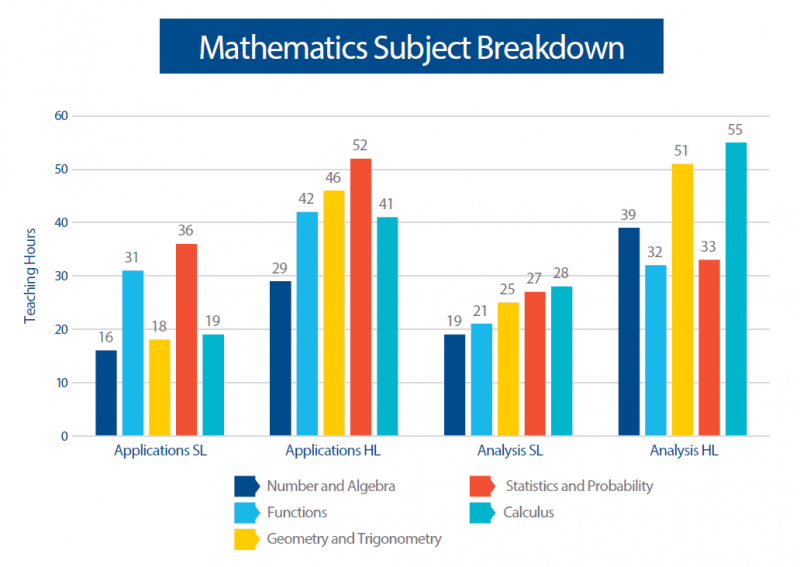Pre-College Advising • Pre-College Planning Guide
The New IB Mathematics Curriculum
POSTED ON 04/30/2019 BY The Red Pen

To address the needs of a modern classroom and to ensure that each subject equips students with the tools required to succeed in the changing world, the International Baccalaureate (IB) reviews the IB Diploma Programme (IBDP) curriculum on a seven-year teaching cycle. This is why, from August 2019, IB students will study a revised IBDP mathematics syllabus so that they can cultivate a more informed and applied environment of learning as compared to years of textbook education.
The new syllabus aims to make them more adept at critical thinking in mathematics since technological advances are making some skills redundant. In addition to this, the new mathematics DP offers students more choices as well as offers schools greater flexibility in the way they group students, schedule lessons and teach mathematical content.
What exactly has changed in the IBDP mathematics syllabus?
Previously, an IB student had three options–generalised mathematics at a higher level (HL), at a standard level (SL) or Math Studies. There was also the option of Further Math at HL, which is rarely offered in IB schools in India. However, with the new syllabus, students have a total of four options–Mathematics: Analysis and Approaches or Mathematics: Applications and Interpretation, each offered at HL and SL. Here is a breakdown of the subjects.

Source: International Baccalaureate
What is the difference between Mathematics: Analysis and Approaches and Mathematics: Applications and Interpretation?
Broadly, the analysis stream is considered purer and “abstract”, while the applications option is more “applied”.
When studying analysis and approaches, students will focus on honing their mathematical skills, problem-solving and exploring real and abstract applications. This is suited for students who wish to study mathematics at college or subjects that require a deep knowledge of mathematics. This will be taught with and without technology.
Analysis and Approaches at either SL or HL is ideal for students who are interested in studying mathematics, engineering, physical sciences, and some economics.
In comparison, the Applications and Interpretation option is for students who wish to solve real problems using mathematics. The emphasis here will be on exploring mathematical models and understanding the practical components of the subject. Students interested in studying social sciences, natural sciences, medicine, statistics, business, engineering, some economics, psychology, and design in college should opt for applications and interpretation at SL or HL.
There are broad guidelines on the IB website that indicate which stream of mathematics would be suitable for which type of student.
Apart from this, certain colleges might have specific requirements for particular courses. For example, the University of Cambridge requires all students to take HL Analysis and Approaches for any course where mathematics is a requirement. Usually offer holders require a 7,7,6 in all HL subjects. If this option is not available, then you can contact the college for further guidance. On the other hand, the University of Oxford will accept students who receive a 7 in either Analysis and Approaches or Applications and Interpretation at HL, except for the chemistry programme.
What are the external assessments?
Both these streams, either at SL or HL will have two written final exam papers, consisting of short and long answers. Additionally, HL students will have an extra Paper 3, which will be a one-hour problem-solving paper, possibly requiring the use of spreadsheets and graphing software.
Are the Internal Assessments going to change?
The main difference in the Internal Assessment (IA) is that the previous Project is changing to Exploration. Students will now spend 30 hours developing investigational, problem-solving, collaboration and modelling skills; the culmination of which will be assessed through an IA component. An independent exploration of an area of mathematics chosen by the student, the IA is internally assessed by the teacher and externally moderated by the IB and contributes towards 20 percent of the overall mark.
In order to build an authentic understanding of the subject, the IB aims to create immersive situations within the classroom so that students can apply the theory that they have learned. The new IBDP mathematics syllabus will focus on developing the skills of analysis, abstraction and generalisation, risk awareness and statistical literacy, algorithmic thinking, modelling and inquiry.
All in all, the new curriculum encourages the core belief of the IB pedagogy of ‘learning through inquiry’. As Ibrahim Wazir, Math IB Chief Examiner summarises, “Rather than offering [students] “rules” to follow, they should be introduced to concepts in an inquiry-based approach. They must see for themselves how a concept is ‘discovered’ and developed into a block that fits into the whole structure of Mathematical knowledge.”
For more information regarding subject selection in high school, read our blog post here. If you would like assistance with board and subject selection or have any specific questions, then get in touch with us.





